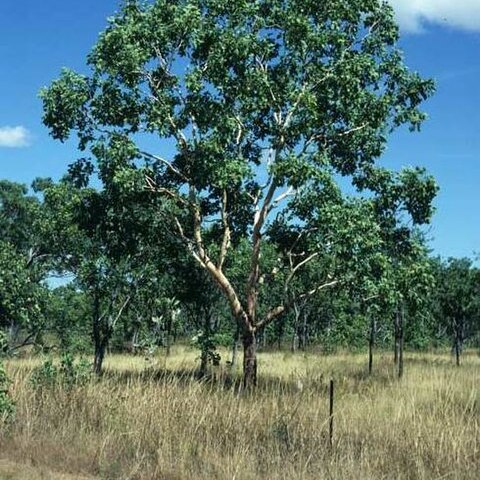Tree to 12 m tall. Forming a lignotuber. Dry season deciduous.Bark usually thin and rough, scaly to coarsely tessellated, orange-brown, variously persistent over the lower trunk, rarely the whole trunk and larger limbs, smooth white to cream and grey above. Branchlets lack oil glands in the pith.Juvenile growth (coppice or field seedlings to 50 cm): stems rounded in cross-section, smooth; juvenile leaves always petiolate, opposite for a few nodes then sub-opposite, large, orbicular to broadly ovate less commonly ± oblong, (6.5)8.5–22.5 cm long, (4.5)8–14 cm wide, base rounded to truncate or tapering, apex emarginate, margin usually crenulate, dull, green, smooth.Adult leaves alternate, petioles (1.7)2–5 cm long; blade deltoid to broadly ovate or elliptical, rarely some leaves broadly lanceolate, 7–16.5 cm long, 4–12.3 cm wide, base truncate to rounded or tapering, margin entire, apex rounded and apiculate or pointed, concolorous or only slightly discolorous, dull, green, smooth, side-veins at greater than 45° to midrib (penniveined), reticulation very dense, intramarginal vein apparently absent (confluent with margin) or rarely visible and very close to margin, oil glands apparently absent.Inflorescence terminal compound, peduncles slender, slightly angular, 0.2–2.2 cm long, buds 7 per umbel, pedicels slender, 0.2–1.3 cm long. Mature buds obovoid to pyriform or almost globular, 0.5–0.6 cm long, 0.3–0.6 cm wide, smooth and ± glossy, scar absent (both opercula shed together at flowering), operculum shallowly rounded and sometimes apiculate, stamens inflexed, all fertile, anthers oblong, dorsifixed, versatile, dehiscing by longitudinal slits, style long, straight, stigma blunt or with a fringe of papillae, locules 3 or 4, the vertical ovule rows indistinct on the placentae. Flowers creamy white.Fruit pedicellate or sometimes subsessile (pedicels 0–1 cm long), urceolate with a very short neck or neck lacking, rim scarcely flared, 0.8–1.4 cm long, (0.7)0.8–1.2(1.3) cm wide, smooth, disc descending vertically, valves 3 or 4, enclosed.Seeds brown, 5–8 mm long, ellipsoidal with terminal wing, hilum ventral. Cultivated seedlings (measured at ca node 10): cotyledons large, reniform; stems rounded in cross-section, setose with long and short bristle-glands; leaves always petiolate (petioles to 1 cm), opposite for at least 14 nodes, or sometimes sub-opposite earlier, broadly elliptical to ovate or orbicular, 3.5–7 cm long, 2–5.5 cm wide, base rounded to truncate or tapering, margin subcrenulate or less commonly entire, apex emarginate or rounded, green, slightly discolorous, setose with bristle-glands especially on midrib on underside, sparse elsewhere.
More
Tree to 15 m, semi-deciduous. Bark flaky, red-brown to light brown, becoming ash-grey, sometimes throughout, or upper branches smooth and white. Juvenile leaves shortly petiolate, orbicular-ovate to elliptic-ovate, apiculate, setose at least on midrib below. Adult leaves alternate or subopposite, broadly ovate to orbicular-ovate, obtuse, rounded at base, thick; lamina 8–13 cm long, 6–9 cm wide, ash-grey, concolorous; lateral veins faint, at 60°–75°; intramarginal vein confluent with margin; petiole terete, 18–40 mm long. Umbels 3–7-flowered; peduncle 10–20 mm long; pedicels 5–10 mm long. Buds ovoid to subglobular; operculum depressed hemispherical or hemispherical-conical, 1–2 mm long, 3–4 mm wide; hypanthium hemispherical, 3–4 mm long and wide. Fruits ovoid, globular or urceolate, 7–13 mm long, 8–14 mm wide. Seeds winged, yellow-brown.
A medium sized tree. It grows 8-12 m high. It loses its leaves during the year. The leaves are smooth and leathery. They are broadly oval. The blade is 8.5-16.5 cm long by 4-10 cm wide. It is dull green. The flowers are cream in groups of 3-7 and in large clusters at the ends of branches. The fruit is an urn shaped woody capsule. It narrows at the mouth. They are about 1 cm across.


